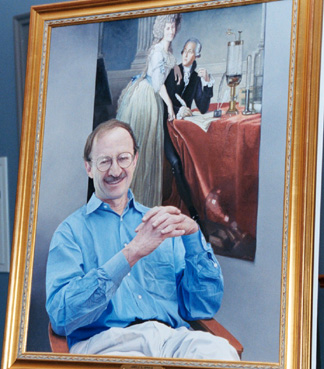
| T H E N I H C A T A L Y S T | M A R C H – A P R I L 2003 |
|
|
|
NIH HANGS VARMUS |
by Celia Hooper |
 |
|
Framed
in Building 1:
The Varmus portrait by Jon R. Friedman now hangs outside the office Harold
Varmus occupied from mid-1993 through 1999
|
A corridor on the first floor of Building 1—just outside the door of the director’s office—became the home for the official portrait of former NIH Director Harold Varmus on January 15. Art aficionados, history-of-science buffs, Varmus fans, and curiosity seekers may find the picture as unusual as its subjects.
At an unveiling ceremony in Wilson Hall, Varmus described some of the references that went into the painting by New York artist Jon R. Friedman. Shown behind Varmus in the painting is a famous portrait of French scientist Antoine-Laurent Lavoisier and his wife, Marie-Anne-Pierrette Paulze, painted by Jacques-Louis David in 1788. This painting-within-the-painting is a good background, Varmus said, because of the many parallels and connections to his life and term as head of NIH.
The first connection is the interplay of science and art, Varmus said. Lavoisier’s connection to art is demonstrated by his commissioning the portrait by David—one of France’s leading artists of the day. Lavoisier’s wife was an artist, and a book of her sketches is shown in the background of David’s painting. The depictions of science in the David painting abound, with Lavoisier’s equipment and notebooks clearly shown in both the David painting and Friedman’s depiction of it. The Metropolitan Museum of Art, where the David painting hangs, notes in its guidebook that "Lavoisier is best known for his pioneering studies of oxygen, gunpowder, and the chemical composition of water. In 1789 his theories were published in the ‘Traite élémentaire de chimie.’ The illustrations in this book were prepared by his wife, who is believed to have studied with David."
Varmus’ choice of Friedman to paint the picture seems to be as deliberate as Lavoisier’s choice of David. Friedman proves that his drafting skills are on a par with David’s in the amazing verisimilitude of his representation of Varmus and his wrinkled blue shirt—so realistic that a viewer wants to touch it to see whether it’s cloth or paint. Varmus’ love of art is also reflected in his choice of the David painting as the backdrop for his portrait—a completely novel choice, as you will see if you inspect the other portraits of NIH directors that line the corridor. Other directors include small pictures of family or the buildings constructed at NIH during their tenure, for example. Varmus’ complex choice of the David painting connects him more symbolically to his passions—science, art, and family—and yet creates a familiar setting for the former director: A poster bearing the Lavoisier portrait is a Varmus favorite and hung for years on his office wall at NIH and, before that, at the University of California at San Francisco. The poster advertises a David exhibit in Paris some years ago.
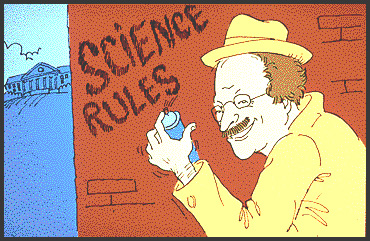 |
|
Still
at large:
At a December 1997 "celebration of leadership," at NIH, which
happened to coincide with his birthday, Harold Varmus received many irreverent
tributes from people in high places—like the cartoon above (a product
of NCI creative genius), depicting how the NIH director integrates art
and science after hours (from The
NIH Catalyst, Jan.-Feb. 1997)
|
Other areas of comparisons that Varmus mentioned are connections to family and the crossing paths of the David painting and Varmus himself. The presence of Lavoisier’s wife in the background of Varmus’ portrait could be viewed as a symbolic representation of his connection to his wife, Constance Casey. Whereas Lavoisier’s wife played a role in illustrating his science, Casey, a journalist, has served as a key reader and editor for Varmus, he said. The provenance of the David painting conveyed it from Lavoisier’s descendants to John D. Rockefeller Jr. and the Rockefeller Institute for Medical Research (now the Rockefeller University in New York), whence it was sold to New York’s Metropolitan Museum of Art. The latter two homes to the painting are in the neighborhood where Varmus now lives and works.
Beyond these connections is the interplay of science and politics. Lavoisier was caught up in the politics of the French Revolution, not so much by his science as by other jobs he held, including commissioner of gunpowder and tax collector. Lavoisier’s controversial status attending the gunpowder commission led David to withdraw the portrait from the French Academy’s Salon exhibition of 1789. Lavoisier’s work as a tax collector led to his death on the guillotine in 1794, even though he had supported the Revolution.
Varmus’ encounters
with the political world were happier, and many observers of his interactions
with politicians cite his remarkable ability to explain to nonscientists the
compelling advances and pressing needs of biomedical research. But, as has been
true for all directors of NIH, Varmus’ work was surrounded by political
storms—from stem cells to electronic publishing and convincing Congress
to support new construction and a doubled budget. Varmus’ fate, so far,
is his hanging—on the first floor corridor—yet keeping both his head
and his life. Varmus is now the president of the Memorial Sloan-Kettering Cancer
Center in New York. ![]()
| PICTURES AT AN EXHIBITION |
WHO'S THAT HANGING IN WILSON HALL?
Mutual Regard Former NIH director Harold Varmus (right) shakes the hand of portraitist Jon R. Friedman. Current NIH director Elias Zerhouni is in the background, and facing them all is the solemn likeness of Luke Ingalls Wilson, after whom Wilson Hall is named and whose visage reflects the more somber mode of traditional portraiture.
Luke Wilson (1872–1937) was a wealthy man who owned the property on which NIH now sits. He inherited his wealth from a Chicago family that made men’s clothes (particularly, men’s underclothes). He did not do anything related to science. In the 1930s, he and his wife, Helen Woodward Wilson (of the Woodward & Lothrop department store family), whose photo also hangs in Wilson Hall, owned property with other wealthy Washingtonians along Rockville Pike, when it was a rural area. These estates were used primarily as summer homes. In 1935, Wilson offered his estate, called "Treetops," to the federal government, hoping that it would be used as a place for an institute to promote peace (he was active in left-wing peace movements between World Wars I and II; he also no doubt appreciated the tax relief he would get by donating this land). No one in the State Department was interested in the offer, so it was circulated around the government. The NIH, then located at 25th and E Sts., N.W., in the District, was experiencing a shortage of space for housing research animals. Then— Assistant Surgeon General Lewis Ryers Thompson, soon to become NIH director, followed up on the Wilsons’ offer and obtained the land for this purpose. In 1936, however, the more conservative Surgeon General Hugh Cumming was replaced by a Roosevelt New Dealer, Thomas Parran, who promptly appointed Thompson, another liberal Democrat, to head NIH, and the two of them seized the opportunity afforded by the Wilson offer to rebuild the entire NIH in Bethesda. In 1937, as construction began, Luke Wilson died of cancer at about the same time the National Cancer Institute was created. Helen Wilson was then motivated to donate extra land to build Building 6, the original Cancer Institute Building, along with the five buildings and the PHS officers’ quarters (along Cedar Lane) included in the first wave of construction. The Stetten Museum has a website in the early stages of development called "Seventy Acres of Science" about this story—stay tuned. —Victoria
Harden |
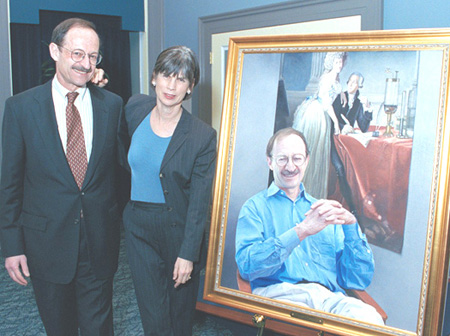 |
|
|
A
leap off the canvas:
Harold Varmus and Constance Casey—21st century counterparts to the
Lavoisiers of the late 18th?
|
|
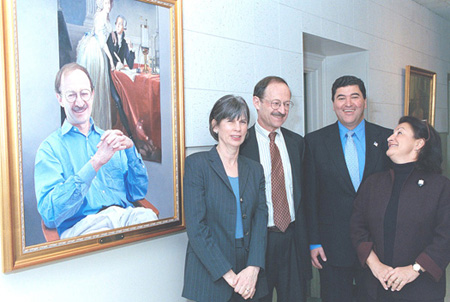 |
|
|
Hanging
out:
Editor Constance Casey (left) and pediatrician Nadia Azza (right) flank
the former and current NIH directors—their respective husbands, Harold
Varmus and Elias Zerhouni.
|
|
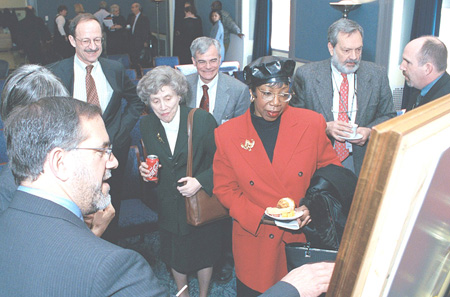 |
|
|
Faces
in the crowd . . .
|